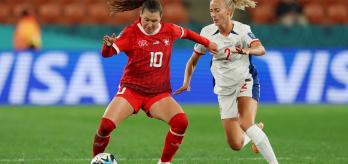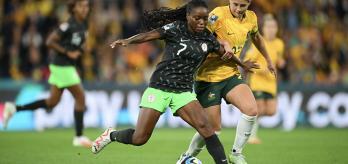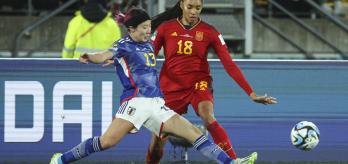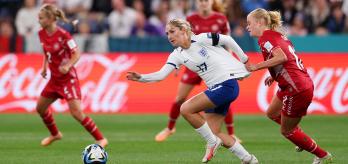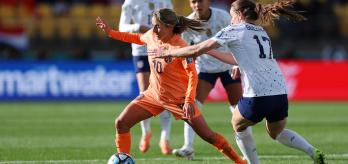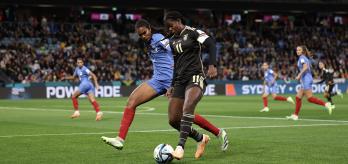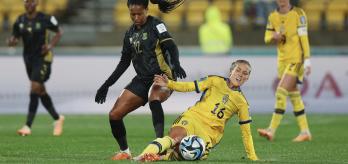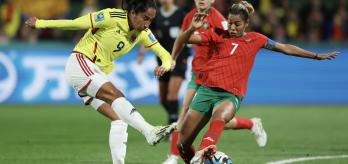Group H arguably produced the shock of the tournament so far on the final day, when two-time World Cup winners Germany could only draw 1-1 with a resolute Korea Republic team and were eliminated at the group stage for the first time in Women's World Cup history. Colombia topped the group, spearheaded by 18-year-old Linda Caicedo, and they were followed into the last 16 by a Morocco side making a big impact on their first World Cup appearance.
Colombia
Belinda Wilson: Colombia utilise a ball-orientated mid-to-low block defensive strategy, directing opponents into wide areas and applying direct pressure to disrupt their progress and regain possession efficiently.
In possession, Colombia prioritise swift transitions, either by finding the highest player, who then takes on defenders, or by passing to the wide forwards, usually Linda Caicedo (18) and Leicy Santos (10). The wide forwards excel in using their speed to exploit spaces behind defenders, creating dangerous 1v1 situations. Their attacking strategy involves direct play from their goalkeeper (Catalina Pérez) and backline, with long passes often targeting Mayra Ramírez (9), who acts as a pivot, distributing the ball to midfielders between the lines.
The midfielders then deliver passes into the wide channels, enabling the very quick, technical and physical wide forwards to receive the ball and drive into the box, aiming to create 1v1 scenarios and generate scoring chances. Colombia have showcased their ability to transition effectively and pose a significant threat in attacking phases of the game.
Morocco
Mónica Vergara: Morocco had a clear 4-4-2 shape when out of possession, and their defensive strategy was to play in a compact mid or low block to make it difficult for the opposition to play through them. Their aim was to keep their shape while individual players pressed their opposite numbers to regain possession. In their second and third matches, their percentages in defensive transition and counter-press improved.
In possession, Morocco played forward quickly. In the attacking transition, they looked to find their forwards by moving the ball forward into feet or playing the ball in behind to try and exploit spaces.
This is their first appearance in a World Cup, and they have qualified from the group at the first attempt.
Germany
Anja Mittag: As one of the tournament favourites, Germany started their games in a 1-4-2-3-1 build up. They surprised by fielding an actual midfielder, Svenja Huth, at right-back and played out from the back with a back-three. They tried to switch play to use their wide players for 1vs1 situations and looked for crosses, which mostly found Alex Popp. Alex led her team with important goals and was difficult to defend against with her incredible aerial strength.
Germany excelled in counter-pressing and winning the ball back quickly with many players around the ball. Out of possession they played in a compact and tight 1-4-2-3-1 formation. Huth dropped back in the back line and forced the opponents out wide. Either way, elimination in the group stage is a big disappointment for Germany.
Korea Republic
Belinda Wilson: Korea Republic employs a mid-to-low defensive block with a ball-orientated defensive strategy in the central corridor, aiming to force their opponents wide. Once the opposition finds themselves in the wide channels, the Koreans employ a direct and coordinated pressing approach to put pressure on the ball carrier. If the ball enters the midline in the central corridor, they are not hesitant to drop further into a low block when the opposition has sustained possession.
This collective effort enables them to press effectively, disrupting the opposition's attacking rhythm, and they are happy to defend the cross. In their build-up play, South Korea prefer to utilise long balls to their central forwards, such as Casey Phair (19), who then involve the wide forwards like Yuri Choe (11) and Garam Chun (15) to quickly progress into the final third. This direct approach signifies a strategic shift from their previous possession-based play in past tournaments, where they emphasised combination plays through their midfield pivots to advance up the field and create goal-scoring opportunities.








